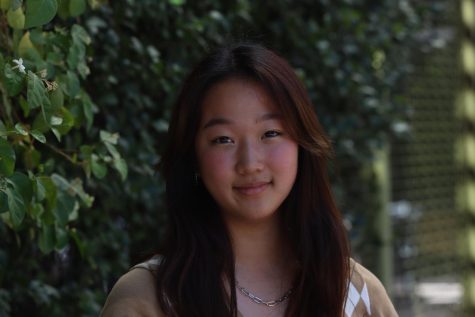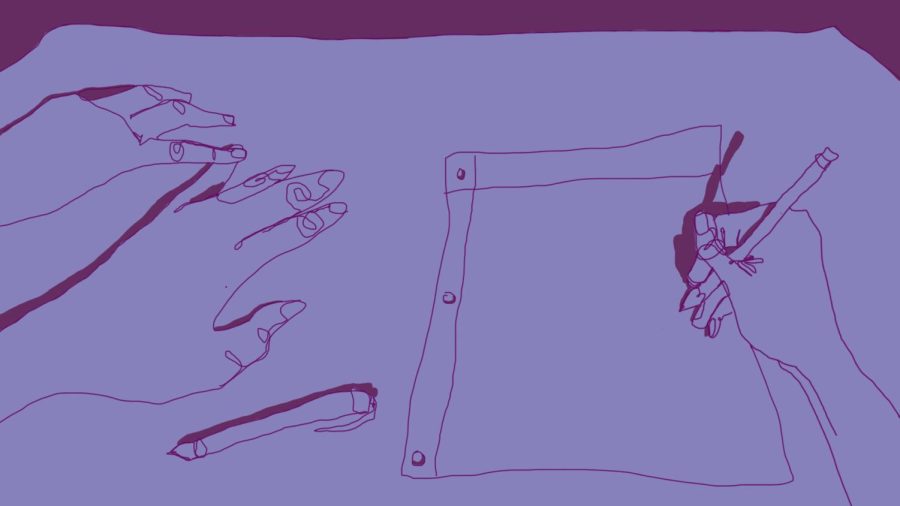PDA on campus: Thoughts on policies
PDA in the classroom.
As February 14 draws nearer, the number of “couple TikToks” on my For You page seems to be multiplying. For those who aren’t familiar with couple TikToks, they involve the people in a relationship taking cute selfies and videos, usually to romantic audios, and feature them hugging, kissing, holding hands or even rubbing noses. While viewing these couple TikToks is now a common daily occurrence, it seems that seeing public displays of affection (PDA) during the school day is something less familiar to Castilleja students and faculty. From teachers to students, people react to witnessing PDA differently. However, with the advent of PDA on the Castilleja campus, students have begun to wonder: What are the rules and restrictions regarding public affection?
When asked her opinion on the implementation of an official policy, Helen Shanks, Junior Class Dean, responded, “I don’t know. I think we have enough boundary guides on what’s inappropriate. I think good judgment comes into play here.” From her prior experience of teaching at co-ed high schools and colleges, Shanks believes that students have the authority and maturity to make their own decisions based on common sense rather than hard and fast rules.
“Within the classroom, if I had two students who were dating, I wouldn’t want to see them sitting and holding hands because it’s not just about the teacher,” Shanks said. “It’s also about the people around them, and it’s bringing attention to them when the attention should be on the learning.”
Shanks believes that when the affection shifts the focus from the learning material to those engaging in PDA, that’s where issues arise. “I don’t have any issues with PDA outside of teaching and educational spaces. So as long as it’s not completely overt, I don’t have any issue with that outside of the class. I think that’s the same at any high school or even workplaces,” Shanks relayed.
For instance, Shanks recalled witnessing students draped over one another during Upper School Meeting. Though the Chapel Theater may not technically count as a classroom, Shanks urges students to see that there’s a time and a place for certain behaviors. She questions, “How would you feel if you were to see two teachers doing the same thing?”
In response to Shanks’ idea on space separation, a student agreed that decisions should be left to students’ best judgments. Unfortunately, this student confides that it is disheartening for her as a queer person when teachers make assumptions on her dating status simply because she is holding hands with someone or because the other person with which she is being tactile is also queer. This student recalled instances when she and a friend have been called out for being affectionate when nearby, two straight friends were displaying a similar level of affection. “Just as long as you have the same standards for all your students, then that’s fine,” she said. “But I feel like if you’re in the library during a free period, then I think that shouldn’t count as a learning space because you’re just there to relax and presumably hang out. Especially since it’s colder outside, we need to be more okay with indoor spaces.”
When asked about the implementation of a policy, she stated that a policy would be difficult to uphold as most of the public affection for her takes place between platonic relationships and not romantic ones. “I’m not super tactile with my family, and I know some of my friends aren’t because we all have this level of reservation around our family because, you know, there’s a disconnect there,” she said. “And for a lot of people—especially queer people—friends are the main source of where we get that physical affection. A lot of the time we only really see our friends at school and at school activities. Not only is there already a double standard, but queer students generally need that support from their friends because it’s not a shared experience that you necessarily have with your family.”
Monica Sidana ‘23 also agreed that there shouldn’t be any policy implemented. “You can’t restrict where people are allowed to express their love for each other spatially. I don’t think that’s ethical. The reason why I say that is because I think PDA is the interaction between two people— a private interaction,” Sidana added. “And so even though they may be doing it in the wrong space, I think it’s an intimate moment, and people deserve to have that.”
That being said, Shanks emphasized that “we’re an incredibly inclusive community. Obviously, part of growing up is practicing and thinking about romantic relationships. But part of growing up is also knowing when it’s appropriate to show PDA and when it’s not.”
Sidana shared that should PDA make a “significant number of people uncomfortable, then some intervention is appropriate to curb the behavior. But otherwise, if it’s hugging or holding hands, then those are all reasonable interactions that someone in a romantic relationship can have.”
On a similar note, the student remarked that she would reflect by asking: “Where in real life would this be appropriate and inappropriate? Because at a public library, no one’s gonna care if two people are holding hands, maybe not making out, but holding hands or cuddling. I feel like a lot of the time when we try to prepare people for the real world, we end up over-preparing them to fit into a specific corporate mold. And that’s just not the real world.”
Some truth remains that while teachers and faculty will do their best to prepare students for the “real world,” the world will continuously change and adapt with the times. What might be viewed as “scandalous and disruptive” may just be a sign of platonic physical support.
With certain spaces or teachers being more lenient towards affection, the student observed that “now I’m also thinking about in what locations and around what teachers am I allowed to relax and be with my friends, and where do I have to be very cautious about who I am and who I interact with? I feel like I always have to have a certain level of awareness of who’s around me, and I don’t want to make assumptions, but I’m quite sure that not all students are constantly having to do that.”
Learning how to balance professionalism and student needs may continue to be a push-pull for both students and faculty. However, as long as we continue to remain open-minded and empathetic towards others, there will be a space for everyone to find comfort and acceptance. As Sidana puts it, “Young love, man. Just let it happen.”
When asked if she feels uncomfortable witnessing PDA, Sidana voiced, “No, I’m not obsessed with other people and what they’re doing. I mean, do I feel bitter because I’m single? Sure. But if I see two people hugging or holding hands, they can do whatever they want. Ultimately, at the end of the day, it doesn’t affect me. I can just look somewhere else if I really feel uncomfortable.”
Shanks urges that should students feel uncomfortable witnessing others engaging in PDA, they are encouraged to speak with a grade dean or advisor. “For me, it’s always about being inclusive,” Shanks said. “But I think that means that that’s broader, that that’s inclusive for everybody who might also be feeling uncomfortable because when you’re in a learning environment, you shouldn’t be thinking about anything else other than learning.”

Kelly Yang is one of the Co-Editors-in-Chief of Counterpoint. This is her fourth year as part of the Counterpoint team and her second year as an EIC. When...


